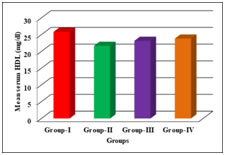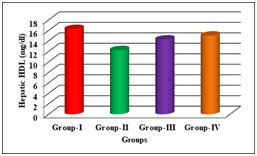Official Journals By StatPerson Publication
|
Table of Content Volume 10 Issue 1 - April 2019
Preclinical evaluation of hypolipidemic effect of hesperidin in high cholesterol diet model in wistar albino rats
Pradeep Kumar V1, Vijai Sundar E2*
1Clinical Pharmacologist, Apollo Hospitals, Chennai, Tamil Nadu, INDIA. 2Assisatnt Professor, Department of Pharmacology, Kanyakumari Government Medical College, Asaripallam, Kanyakumari (Dist), Tamil Nadu, INDIA. Email: vijaisundar@gmail.com
Abstract Background: Hyperlipidemia is a major cause of various coronary heart diseases. Early diagnosis and initiation treatment can reduce the mortality. The present study aimed to evaluate the hypolipidemic effect of hesperidin in high cholesterol rats. Materials and Methods: Wister Albino rats weighing 200-250gm were used in this study. 24 rats were divided into four groups each of 6 rats. G-I (Normal diet), G-II (High cholesterol diet), G-III (High cholesterol diet + Hesperidin 100 mg/kg) and G-IV (High cholesterol diet + Hesperidin 200 mg/kg). Four groups tetrad with respective drugs for 90 days. At the end of experiment blood and hepatic samples were collected and used for estimation of total cholesterol, triglycerides, HDL, LDL and VLDL. SPSS software used for statistical analysis. Data was expressed in mean and standard deviation. Results: Group-I showed significant effect in lipid profile compared to group-II. Group-III and IV showed significant results in lipid profile compared to Group-I and II. Group-IV showed better effect than group-III. Similar effects were observed in hepatic lipid profile. Conclusion: Animals treated with hesperidin showed significant effect on blood and hepatic lipid profile. From the study results it can be concluded that hesperidin can be used in the prevention and treatment of hyperlipidemia. Key Word: Cholesterol, hyperlipidemia, hespiridin, serum, hepatic, lipid profile.
INTRODUCTION Hyperlipidemia is a major cause of atherosclerosis and atherosclerosis induced conditions, such as coronary heart disease (CHD), ischemic cerebrovascular disease and peripheral vascular disease1,2. Hypercholesterolemia is one of the most important risk factor for the development of cardiovascular diseases like atherosclerosis and its complications, acute myocardial infarction or hypertension3. These conditions cause morbidity or mortality in a majority of middle-aged or older adults and account for about one third of all deaths of persons in this age range4,5. The incidence and absolute number of annual events will likely increase over the next decade because of the epidemic of obesity and aging. The major conventional risk factors for Coronary Heart Disease (CHD) are elevated LDL-C, reduced HDL-C, cigarette smoking, hypertension, type 2 diabetes mellitus, advancing age and a family history of premature CHD events in a first degree relative. Control of the modifiable risk factors is especially important in preventing premature CHD [6]. Hesperidin has been pharmacologically evaluated as a potential anticarcinogenic agent because of its antioxidant activity. Other biological effects include immune-modulation and scavenging of peroxynitrite as a reactive oxidant7-9. Present study was done to explore the hypolipidemic effect of Hesperidin through its antioxidant mechanism in Wistar Albino rats on hypercholesterolemic diet.
MATERIALS AND METHODS Animals: Wistar Albino male rats of 200-250g were used for the study. Animals were housed in well ventilated room (temperature 23 + 2oC, humidity 65-70% and 12h light/dark cycle) at Central Animal House, Rajah Muthiah Medical College and Hospital, Annamalai University. The institutional animal ethical committee (Register No.160/1999/CPCSEA), Annamalai University, Annamalai Nagar, India approved the experimental design (Proposal No.883, dated 10.01.2012). Study groups Group-I: Normal diet Group-II: High Cholesterol diet (1% Cholesterol, 0.5% Sodium Cholate, 1% Coconut Oil). Group-III: High Cholesterol diet+ Hesperidin (100 mg/kg orally OD) Group-IV: High Cholesterol diet+ Hesperidin (200 mg/kg orally OD) Procedure: All studies were conducted in accordance with Committee for the Purpose of Control and Supervision on Experiments on Animals (CPCSEA) norms and the National Institute of Health guidelines “Guide for the Care and use of Laboratory Animals”. Male wistar rats, housed in polypropylene cages under hygienic conditions adapted to the laboratory conditions for a week were used for the study. The rats were divided into 4 groups of which 6 rats in each group. Wistar rats of 7 to 8 weeks old weighing about 200-250g fed with normal pellet diet and water in control group and high cholesterol diet (1% Cholesterol, 0.5% Sodium cholate, 1% Coconut oil mixed with normal pellet powder) into experimental group and water ad libitum throughout the study. The study period is for 13 weeks. Hypercholesterolemia in rats was induced by administration of high cholesterol diet (1% Cholesterol, 0.5% Sodium cholate, 1% coconut oil) for 90 days in standard chow diet. After the study period, the animals in all groups were subjected to overnight fasting. Blood samples were drawn by retro orbital puncture for biochemical analyses. The faecal matter was collected from all the groups during the last five days of the experimental study and processed for biochemical analyses. The whole blood from rats of all the groups was collected in a covered test tube. After collection of the whole blood, it was allowed to clot undisturbed for 15-30 minutes. Remove the clot by centrifuging at 1,000-2,000 x g for 10 minutes in a centrifuge. The supernatant serum was obtained. Total cholesterol, HDL, LDL and VLDL were estimated by auto-analyzer method using standard procedure 10,11. Statistical analysis: The data was expressed in mean and standard deviation. Statistical Package for Social Sciences (SPSS 16.0 version) used for analysis. One was ANOVA (Post hoc) followed by Dunnet t test applied to find the statistical significant between the groups. p value less than 0.05 (p<0.05) considered statistically significant at 95% confidence interval.
RESULTS Serum lipid profile of group-II showed significant (p<0.05) difference increase in TC, TGs, LDL and VLDL compared to group-I. Group-III and IV showed significant decrease in TC, TGs, LDL and VLDL compared to group-II which is statistically significant (p<0.05). Group-IV showed better effect than Group-III (p>0.05). HDL level is significantly reduced in Group-II compared to group-I (p<0.05). Group-III and IV showed significant increase in HDL level compared to group-II (p<0.05) (Table-1 and Graph-1). Hepatic lipid profile also showed similar effects (Table-2 and Graph-2). Both serum and hepatic lipid profile hespiridin groups showed significant difference compared to group-II. Group-III and IV not showed any significant difference.
Table 1: Effect of hesperidin on serum total cholesterol, triglycerides, LDL and VLDL levels
(*p<0.05 significant compared Group-I with other groups, #p<0.05 significant compared Group-II with other groups, p>0.05 no significant difference compared Group-III with Group-IV)
Table 2: Effect of hesperidin on hepatic total cholesterol, triglycerides, LDL and VLDL levels
(*p<0.05 significant compared Group-I with other groups, #p<0.05 significant compared Group-II with other groups, p>0.05 no significant difference compared Group-III with Group-IV)
Graph 1: Effect of hesperidin on serum HDL levels Graph 2: Effect of hesperidin on hepatic HDL levels DISCUSSION Hyperlipidemia is a well known risk factor for cardiovascular disease, especially atherosclerotic coronary artery disease (CAD). In Indian population the risk factors for coronary artery disease occur at much lower levels of total cholesterol and low density lipoproteins than other populations. One of the major causes of disease burden in both developed and developing countries is raised total cholesterol level leading to Ischemic heart disease and stroke. Cholesterol feeding has been often used to elevate serum or tissue cholesterol levels to assess hypercholesterolemia related metabolic disturbances and subsequent atherosclerosis in different animal models12. The most commonly used method to evaluate antihyperlipidemic and antiatherosclerotic drugs is “Cholesterol diet induced hyperlipidemia in rats.” Cholesterol feeding alone however does not affect the serum triglyceride level. It is assumed that a high level of saturated fat in addition is required to significantly elevate serum triglyceride levels in rat models 13. Diet containing saturated fatty acid and cholesterol elevate the serum lipid levels by increased activity of HMG CoA reductase, down regulation in LDL receptors, increased activity of CETP and decreased activity of LCAT enzyme14. Cholic acid is added with high cholesterol diet to increase cholesterol absorption and to suppress cholesterol 7α- hydroxylase activity that results in decreased cholesterol excretion15. Rats fed on high cholesterol diet for 60- 90 days show significant increase in serum and hepatic lipid profile16. In the present study also male wistar rats were used and hypercholesterolemia was induced by giving high cholesterol diet (1% Cholesterol, 0.5% Sodium cholate and 1% coconut oil) for 90 days in standard rat chow diet. At the end of 90 daysbiochemical analyses revealed increased serum and hepatic cholesterol, triglycerides, VLDL-C and LDL-C and reduced the level of HDL-C in hypercholesterolemic rats. A rise in LDL may cause deposition of cholesterol in arteries and aorta and hence is a direct risk factor for coronary heart disease17. Low HDL-C is the most common lipoprotein abnormality in patients with CHD and is predictive of subsequent CHD events, even when total cholesterol is within the desirable range 18. Treatment with Hesperidin significantly reduced the serum and hepatic Total cholesterol, Triglycerides, LDL-C, VLDL-C and increased HDL-C levels in high cholesterol fed rats. Thus the effect of Hesperidin on lipid profiles in hypercholesterolemic rats revealed not only its hypolipidemic action but also its ability to raise HDL-C. HDL-C inhibits the oxidation of LDL-C and the expression of cellular adhesion molecules, monocyte recruitment and thereby prevents the progression of atherosclerosis.
CONCLUSION The biochemical analyses prove that Hesperidin has hypolipidemic effect in high fat diet model. The efficacy of Hesperidin in reducing the atherosclerotic changes in aorta and hepatic fatty infiltration in high cholesterol diet fed rats were probably due to its hypolipidemic activity, ability to raise the HDL-C and through its antioxidant activity. Hence Hesperidin as a nutritional agent can be utilized in conjunction with other hypolipidemic agents. Further studies are required to study the role of Hesperidin on cytokines and growth factors which contribute to atherogenesis and its complications.
REFERENCES
|
|
 Home
Home


